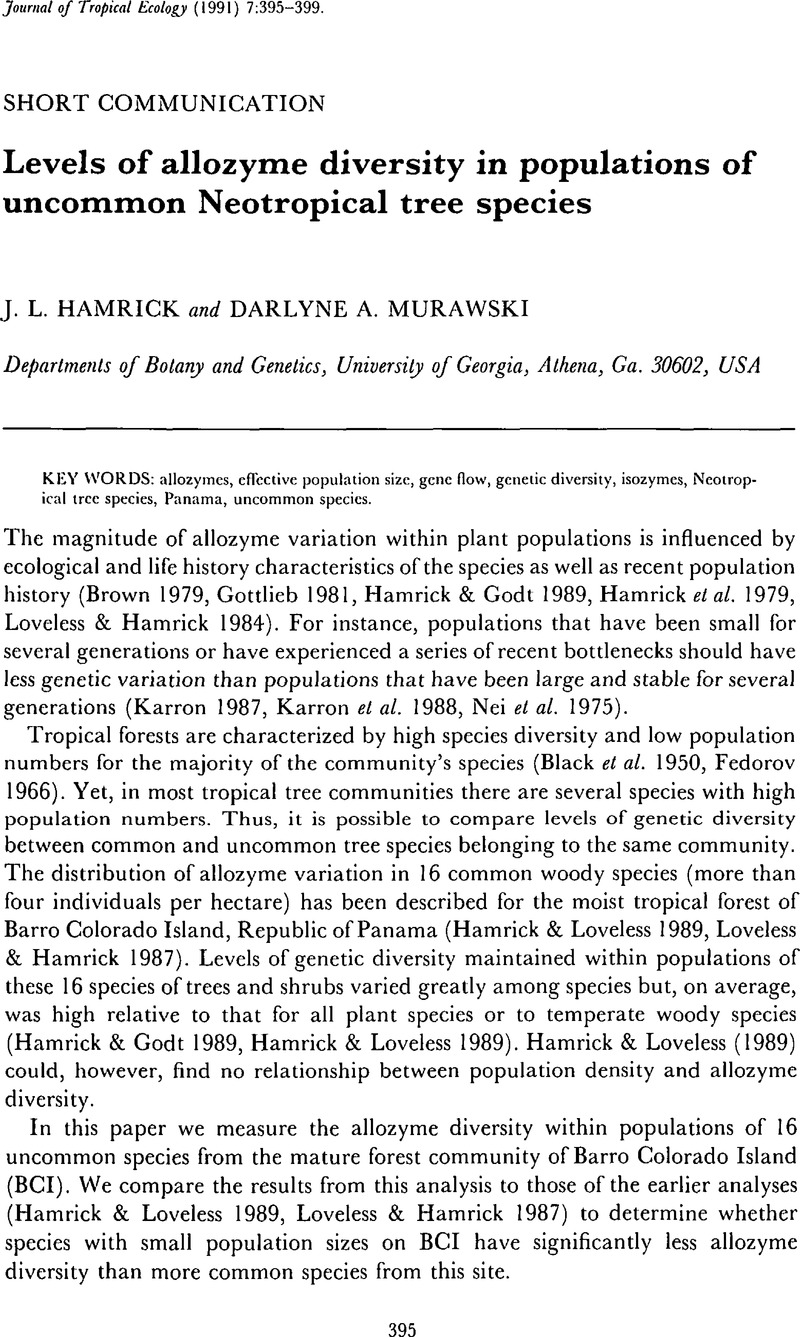Crossref Citations
This article has been cited by the following publications. This list is generated based on data provided by Crossref.
Thomson, James D.
Herre, E. A.
Hamrick, J. L.
and
Stone, J. L.
1991.
Genetic Mosaics in Strangler Fig Trees: Implications for Tropical Conservation.
Science,
Vol. 254,
Issue. 5035,
p.
1214.
Loveless, M. D.
1992.
Population Genetics of Forest Trees.
Vol. 42,
Issue. ,
p.
67.
Loveless, M. D.
1992.
Isozyme variation in tropical trees: patterns of genetic organization.
New Forests,
Vol. 6,
Issue. 1-4,
p.
67.
Lowman, Margaret D.
and
Moffett, Mark
1993.
The ecology of tropical rain forest canopies.
Trends in Ecology & Evolution,
Vol. 8,
Issue. 3,
p.
104.
Ashton, P S
1993.
The community ecology of Asian rain forests, in relation to catastrophic events.
Journal of Biosciences,
Vol. 18,
Issue. 4,
p.
501.
Murawski, Darlyne A.
and
Bawa, Kamaljit S.
1994.
Genetic structure and mating system of Stemonoporus oblongifolius (Dipterocarpaceae) in Sri Lanka.
American Journal of Botany,
Vol. 81,
Issue. 2,
p.
155.
Hall, Pamela
Orrell, Lelia C.
and
Bawa, Kamaljit S.
1994.
Genetic diversity and mating system in a tropical tree, Carapa guianensis (Meliaceae).
American Journal of Botany,
Vol. 81,
Issue. 9,
p.
1104.
Rogstad, Steven H.
1996.
Genomes of Plants and Animals.
p.
1.
Alvarez-Buylla, E. R.
García-Barrios, R.
Lara-Moreno, C.
and
Martínez-Ramos, M.
1996.
DEMOGRAPHIC AND GENETIC MODELS IN CONSERVATION BIOLOGY: Applications and Perspectives for Tropical Rain Forest Tree Species.
Annual Review of Ecology and Systematics,
Vol. 27,
Issue. 1,
p.
387.
Sheely, Deborah L.
and
Meagher, Thomas R.
1996.
Genetic diversity in micronesian island populations of the tropical tree campnosperma brevipetiolata (anacardiaceae).
American Journal of Botany,
Vol. 83,
Issue. 12,
p.
1571.
Nason, John D.
Herre, E. Allen
and
Hamrick, James L.
1996.
Paternity analysis of the breeding structure of strangler fig populations: evidence for substantial long‐distance wasp dispersal.
Journal of Biogeography,
Vol. 23,
Issue. 4,
p.
501.
Hogan, Kevin P.
1996.
Tropical Forest Plant Ecophysiology.
p.
497.
Shapcott, A.
and
Playford, J.
1996.
Comparison of genetic variability in remnant and wide-spread rainforest understorey species of Austromyrtus (Myrtaceae).
Biodiversity and Conservation,
Vol. 5,
Issue. 7,
p.
881.
Doligez, Agnes
and
Joly, Helene I
1997.
Genetic diversity and spatial structure within a natural stand of a tropical forest tree species, Carapa procera (Meliaceae), in French Guiana.
Heredity,
Vol. 79,
Issue. 1,
p.
72.
ALDRICH, PRESTON R.
HAMRICK, J. L.
CHAVARRIAGA, PAUL
and
KOCHERT, GARY
1998.
Microsatellite analysis of demographic genetic structure in fragmented populations of the tropical tree Symphonia globulifera.
Molecular Ecology,
Vol. 7,
Issue. 8,
p.
933.
Loveless, M D
Hamrick, J L
and
Foster, R B
1998.
Population structure and mating system in Tachigali versicolor, a monocarpic neotropical tree.
Heredity,
Vol. 81,
Issue. 2,
p.
134.
Hamilton, William D.
1999.
Evolutionary Theory and Processes: Modern Perspectives.
p.
125.
Shapcott, Alison
1999.
Vagility and the Monsoon Rain Forest Archipelago of Northern Australia: Patterns of Genetic Diversity in Syzygium nervosum (Myrtaceae)1.
Biotropica,
Vol. 31,
Issue. 4,
p.
579.
Shapcott, A.
1999.
Comparison of the population genetics and densities of five Pinanga palm species at Kuala Belalong, Brunei.
Molecular Ecology,
Vol. 8,
Issue. 10,
p.
1641.
Linhart, Y. B.
2000.
Molecular Biology of Woody Plants.
Vol. 64,
Issue. ,
p.
341.





